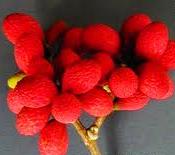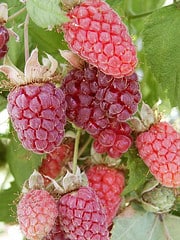The chokeberries (Aronia) are two to three species ofdeciduous shrubs in the family Rosaceae, native to easternNorth America. They are most commonly found in wet woods and swamps. Chokeberries are cultivated as ornamental plants and also because they are very high in antioxidant pigment compounds, like anthocyanins. The name “chokeberry” comes from the astringency of the fruits which are inedible when raw. The berries can be used to make wine, jam, syrup, juice, soft spreads, tea andtinctures. The fruits are eaten by birds (birds do not taste astringency and feed on them readily), which then disperse the seeds in their droppings.
The chokeberries are often mistakenly called chokecherries, which is the common name for Prunus virginiana. Further adding to the ambiguity, there is a cultivar of Prunus virginiana named ‘Melanocarpa’, easily confused withAronia melanocarpa. Chokecherries are also high in antioxidant pigment compounds, like anthocyanins, further contributing to confusion. In fact, the two plants are only distantly related within the Rosaceae.
Health benefits of Chokeberries
- Chokeberries are low in calories and fats but are rich source of vitamins, minerals, antioxidants and dietary fiber.
- Black chokeberries compose significantly high amounts of phenolic flavonoid phyto-chemicals calledanthocyanins. Total anthocyanin content in the choke berries is 1480 mg per 100 g of fresh berries, and proanthocyanidin concentration is 664 mg per 100 g (Wu et al. 2004, 2006). Scientific studies have shown that consumption of berries on regular basis offers potential health benefits against cancer, aging and neurological diseases, inflammation, diabetes, and bacterial infections. (- By Dr. Paul Gross, 2007-07-09).
- Laboratory analyses of anthocyanins in chokeberries have identified the following individual chemicals:cyanidin-3-galactoside, quercetin, peonidin, delphinidin, petunidin, epicatechin, caffeic acid, pelargonidin and malvidin. These flavonoid poly-phenolic antioxidants have proven health benefits through scavenging dangerous oxygen free radicals from the body.
- Cancer research on anthocyanins, where black choke berry preparations were first used to inhibit chemically induced cancer in the rat esophagus by 30-60% and of the colon by up to 80%. Effective at both the initiation and promotion/progression stages of tumor development, choke-berries are a practical research tool and hold a promising therapeutic source, since they contain highest amount of anthocyanins among native North American berries [J. Agric. Food Chem. 50 (12): 3495–500].
- They also rich in flavonoid anti-oxidants such as carotenes, luteins and zeaxanthins. Zeaxanthin has photo-filtering effects on UV rays and thus protects eyes from age related macular disease in the elderly (ARMD).
- Chokeberries are also good source of many antioxidant vitamins like vitamin-C, vitamin A, vitamin E, beta carotene and folate and minerals like potassium, iron and manganese. 100 g of fresh berries provide about 35% of daily recommended levels of vitamin C.
- The oxygen radical absorbency capacity or ORAC (measurement of antioxidant strength of food items) demonstrates choke berry with one of the highest values yet recorded -16,062 micro moles of Trolox Equivalents (TE) per 100 g.

